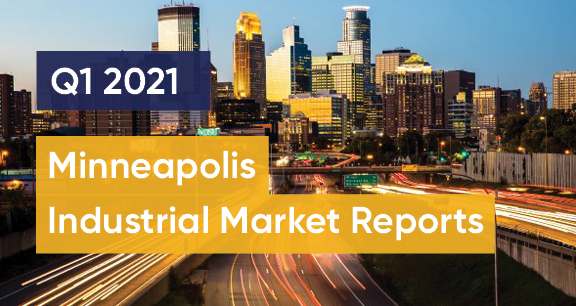Q1 2021 Industrial Market Insight Report

Market Trends
1.) The industrial market continues to be the most resilient sector in commercial real estate and remains the most sought-after product type for investors both nationally and locally.
2.) Speculative developments have gained momentum as demand for industrial/flex space continues to outpace supply. A large up-tick in development activity is expected to be seen in upcoming quarters.
3.) As more institutional investors seek to grow their portfolios in the Twin Cities industrial market, we will likely see asking rents begin to increase in the coming quarters. The current market dynamics are favorable for landlords and this will likely continue for the foreseeable future.
4.) E-commerce continues to be the driving force behind the industrial sector’s strong demand. The pandemic amplified the already growing trend for online shopping, which has shown no signs of slowing.
5.) Construction costs and lead time have increased due to a global shortage of materials.
Gross Rental and Vacancy Rates
(Click to enlarge)
Market Movement
| Tenant | Building | Size | Submarket | Type |
|---|---|---|---|---|
| KSP Fulfillment | NorthPark VII | 221,000 SF | Northwest Metro | New Lease |
| Amazon | Hwy 55 Distribution Center | 142,000 SF | Southeast Metro | New Lease |
| Anagram | 5501 W Old Shakopee Road | 173,000 SF | Southwest Metro | New Lease |
| Mermon | 610 Junction Building 1 | 110,000 SF | Northwest Metro | New Lease |
| Pelican Biothermal | 10100 89th Ave | 117,000 SF | Northwest Metro | New Lease |
Investment Sales
| Buyer | Building | Size | Submarket | Price |
|---|---|---|---|---|
| Platform Ventures | Lakes Distribution Center | 265,500 SF | Northeast Metro | $22 Million |
| Becknell/Raith Capital Partners | 8751 Zachary Ln N | 197,000 SF | Northwest Metro | $17.5 Million |
| STAG Industrial Holdings | 8450 Courthouse Blvd | 80,000 SF | Southeast Metro | $10.1 Million |
| Loyal Oak Management | 14461 Lake Dr NE | 58,000 SF | Northeast Metro | $7.4 Million |
Minneapolis/St. Paul, collectively referred to as the Twin Cities, is the 16th largest MSA with approximately 3.6 million residents and home to 17 fortune 500 public companies’ headquarters. The Twin Cities is also ranked highly for quality of life, labor force participation, health care, and workforce quality. The Twin Cities’ industrial market consists of approximately 263 million square feet. The Minneapolis/St. Paul Minnesota’s job market continues to recover from the negative impacts brought on by COVID-19. In February 2021 Minnesota’s unemployment rate had improved to 4.4%, roughly 2 percentage points below the national average of 6.2%.

